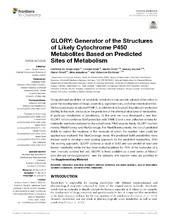| dc.contributor.author | de Bruyn Kops, Christina | |
| dc.contributor.author | Stork, Conrad | |
| dc.contributor.author | Sicho, Martin | |
| dc.contributor.author | Kochev, Nikolay | |
| dc.contributor.author | Svozil, Daniel | |
| dc.contributor.author | Jeliazkova, Nina | |
| dc.contributor.author | Kirchmair, Johannes | |
| dc.date.accessioned | 2020-03-09T13:32:13Z | |
| dc.date.available | 2020-03-09T13:32:13Z | |
| dc.date.issued | 2019-06-12 | |
| dc.Published | de Bruyn Kops C, Stork C, Sicho M, Kochev N, Svozil, Jeliazkova N, Kirchmair J. GLORY: Generator of the structures of likely cytochrome P450 metabolites based on predicted sites of metabolism. Frontiers in Chemistry. 2019;7:402 | eng |
| dc.identifier.issn | 2296-2646 | en_US |
| dc.identifier.uri | https://hdl.handle.net/1956/21459 | |
| dc.description.abstract | Computational prediction of xenobiotic metabolism can provide valuable information to guide the development of drugs, cosmetics, agrochemicals, and other chemical entities. We have previously developed FAME 2, an effective tool for predicting sites of metabolism (SoMs). In this work, we focus on the prediction of the chemical structures of metabolites, in particular metabolites of xenobiotics. To this end, we have developed a new tool, GLORY, which combines SoM prediction with FAME 2 and a new collection of rules for metabolic reactions mediated by the cytochrome P450 enzyme family. GLORY has two modes: MaxEfficiency and MaxCoverage. For MaxEfficiency mode, the use of predicted SoMs to restrict the locations in the molecule at which the reaction rules could be applied was explored. For MaxCoverage mode, the predicted SoM probabilities were instead used to develop a new scoring approach for the predicted metabolites. With this scoring approach, GLORY achieves a recall of 0.83 and can predict at least one known metabolite within the top three ranked positions for 76% of the molecules of a new, manually curated test set. GLORY is freely available as a web server at https://acm.zbh.uni-hamburg.de/glory/, and the datasets and reaction rules are provided in the Supplementary Material. | en_US |
| dc.language.iso | eng | eng |
| dc.publisher | Frontiers | en_US |
| dc.rights | Attribution CC BY | eng |
| dc.rights.uri | http://creativecommons.org/licenses/by/4.0 | eng |
| dc.subject | metabolism prediction | eng |
| dc.subject | metabolite structure prediction | eng |
| dc.subject | rule-based approach | eng |
| dc.subject | sites of metabolism | eng |
| dc.subject | xenobiotic metabolism | eng |
| dc.subject | cytochrome P450 | eng |
| dc.subject | metabolites | eng |
| dc.title | GLORY: Generator of the structures of likely cytochrome P450 metabolites based on predicted sites of metabolism | en_US |
| dc.type | Peer reviewed | |
| dc.type | Journal article | |
| dc.date.updated | 2020-02-12T09:47:05Z | |
| dc.description.version | publishedVersion | en_US |
| dc.rights.holder | Copyright 2019 The Author(s) | en_US |
| dc.identifier.doi | https://doi.org/10.3389/fchem.2019.00402/abstract | |
| dc.identifier.cristin | 1748215 | |
| dc.source.journal | Frontiers in Chemistry | |
| dc.relation.project | Trond Mohn stiftelse: BFS2017TMT01 | |

